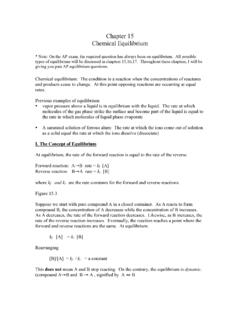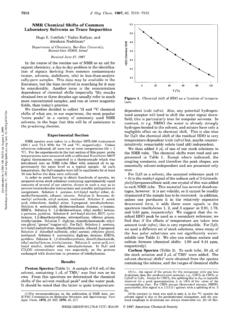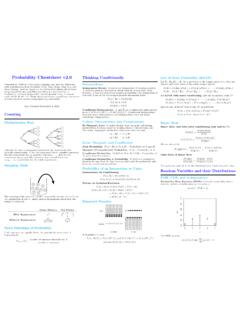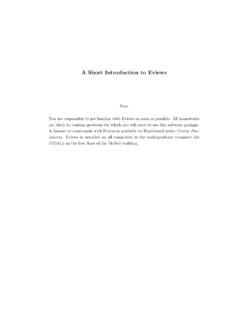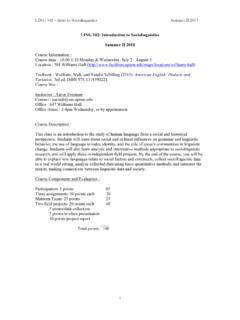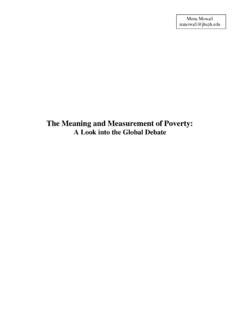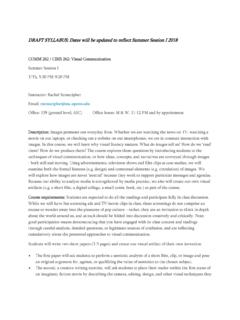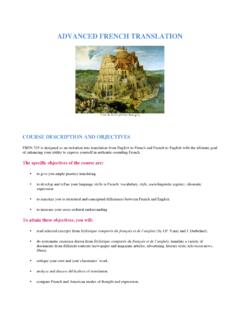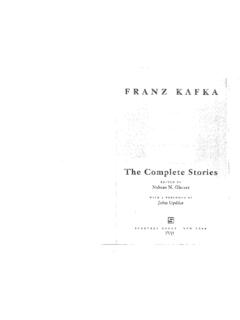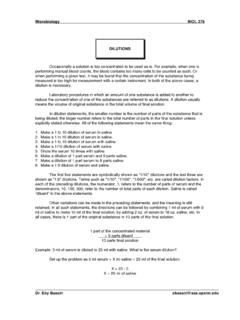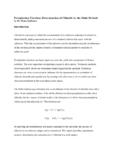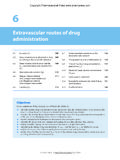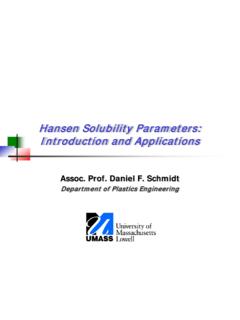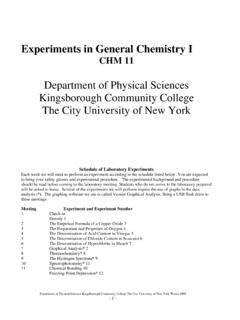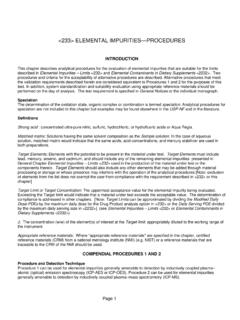Transcription of Identifying and Comparing Properties of Ionic and Covalent ...
1 1 Identifying and Comparing Properties of Ionic and Covalent Compounds in Order to Classify Unknown Compounds. Teacher Version Kim Appleby Justin Barry Sean Wolosin Contents: I. 2 II. 3 III. Outline of 3 IV. Basic Rubric for 4 V. Teacher 4 VI. Pre-Lab 5-8 VII. Part 9 VIII. Part 10 IX. Conductivity Tester Assembly 11 X. Part 12 XI. Follow Up Assessment 13-14 XII. Extension and Closing 15 2 Lab Title: Identifying and Comparing Properties of Ionic and Covalent Compounds in Order to Classify Unknown Compounds. Where This Activity Fits into Curriculum: This lab activity is an appropriate accompaniment for a high school general chemistry course for a unit involving Aqueous Reactions and Solution Stoichiometry which is typically covered early on in a general chemistry curriculum or Intermolecular Forces, Liquid, and Solids which is typically cover later in the year in a general chemistry curriculum.
2 The lab allows students to perform a conductivity test on various substances dissolved in water to qualitatively determine if a substance is an electrolyte or a molecular compound. This aspect of the lab activity allows the student to observe the Properties of both Ionic and molecular compounds in solution and requires that the student interpret results to make a determination about the type of compound they are working with. The lab also allows students to determine the solubility of Ionic compounds and molecular compounds in both polar and non-polar solvents. Lastly the lab requires allows students to qualitatively compare the melting points of both Ionic and molecular compounds.
3 This lab is strictly qualitative due to the fact that the goal of the lab is to have students collect data on three separate macroscopic phenomena that are influenced by the nanoscopic interactions (type of bonds) that each compound involved in the lab has. The student then must reason as to why a certain type of compound will behave a certain way based on the type or class of compound in which it belongs. Prerequisite knowledge: This lab has been designed as a guided inquiry activity in that its purpose is to allow students to explore and eventually determine the answer to a big question. The big question being proposed to the student is how does the bonding involved in a compound (nanoscopic interactions) influence the macroscopic physical Properties that can be observed of the compound?
4 The student is also being asked to apply knowledge gained about these macroscopic interactions to unknown samples that they are given during the lab in order to identify these substances as being covalently bonded or Ionic bonded substances. In order for the student to benefit from this lab activity the student should have a good understanding of the difference between an Ionic compound and a molecular compound. The student should also have a good understanding of the various physical Properties that they will be exploring in the lab activity (conductivity, solubility , melting point). If the lab is being used in a unit on Aqueous Reactions and Solution Stoichiometry, then the student will need to do some research as to what intermolecular forces affect solubility and melting points.
5 If the lab is being used during a unit on Intermolecular Forces, Liquid, and Solids than the student will need to revisit the Properties of an electrolyte and factors influencing conductivity. It should be emphasized that this lab has been designed to encourage the student to perform their own research on each of the various physical Properties that they will be observing during the activity. 3 Purpose and Objectives: Students will use critical thinking skills and previous (as well as gained) knowledge in order to solve a problem. Students will be able to explain how macroscopic observations are influenced by nanoscopic interactions.
6 Students will be able to explain what influences the conductivity of a substance in solution and the Properties of an electrolyte vs. a non electrolyte. Students will be able to describe how the type of bonding in a compound influences the solubility of a compound in polar and non-polar solvents. Students will be able to describe how intermolecular interactions influence the melting point of a compound. Students will be able to describe how bonding influences intermolecular interactions. Master Materials List: Based on a class of 24 students working in groups of 4 24 student safety goggles 24 student aprons Fume hood 6 qualitative conductivity testers (see pg 11 for instructions on how to build these if your school does not have them) Aluminum foil 6 hot plates 6 spatulas (18) 20 mL glass containers with lids Adhesive labels (18) 50 mL beakers 6 glass stirring rods Consumables.
7 Approximately 150 g Naphthalene crystals divided equally into (6) 20 mL glass containers and labeled Unknown Sample A Approximately 150 g potassium chloride crystals divided equally into (6) 20 mL glass containers and labeled Unknown Sample B Approximately 150 g sodium bicarbonate powder divided equally into (6) 20 mL glass containers and labeled Unknown Sample C Approximately 360 mL cyclohexane - (3) 20 mL allotments per group. Activity Synopsis: (this lesson may be split in two separate days) Students will: 1. PreLab (before class)- Answer questions from laboratory experiment report sheet and fill in the chart listing the Properties of known compounds.
8 Review concepts include: Ionic compound composition, molecular compound composition, melting time, and electrical conductivity. Make predictions about the identity of various compounds based on their physical and chemical Properties . 2. Laboratory experiment- Teacher demonstrates safety precautions and how to properly use the conductivity meters. (5 min) Gather the selected supplies from their lab station. Test unknown samples each separately for solubility , conductivity, and melting point. Students will follow all directions under the procedure section of lab manual. (15 min) 3. PostLab- After making observations and recording results, answer the POGIL questions on the experiment report sheet.
9 Make conclusions about the compounds, whether they were Ionic or Covalent and observe any trends among them. (15 min) 4. Laboratory experiment #2- Upon finishing the experimental tests for Unknowns A, B, and C, students will then test unknown D. (5 min) 5. Clean up all lab equipment and materials and properly dispose of all materials as directed in the lab. (5 min) 6. Answer closing POGIL type questions at the end of the lab to test their understanding of the lab. (20-30 min the following class period) 4 Basic Rubric for scoring: PRE-Lab Grading Rubric: Requirement Meets Expectations Minor Errors Serious Errors Compound Research Chart All required information in chart is included and is accurate Some information inaccurate.
10 Information missing or inaccurate. Venn Diagram Definitions Questions For Review Teacher Introduction Notes: Students will bring their completed pre-lab chart and pre-lab questions answered before coming to lab. Students will be instructed what the objective of the lab is and where materials can be found. Safety precautions will be review with the particular materials we are using. A brief procedural introduction of the test will be given (especially for the conductivity test) Students will pair up in to 2-4 people (depending on size of class) and begin working only after all students have their safety goggles on.
